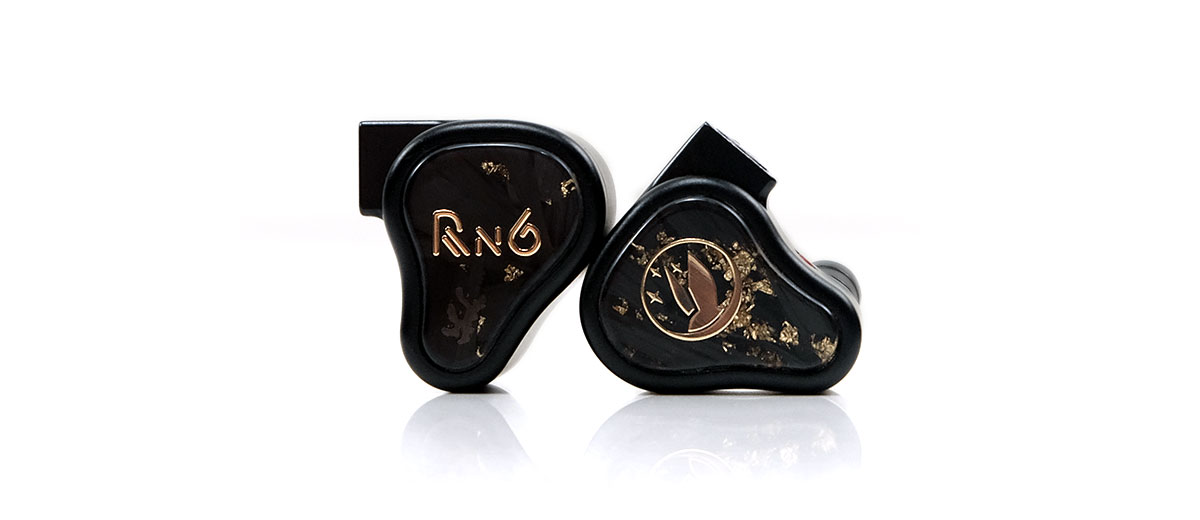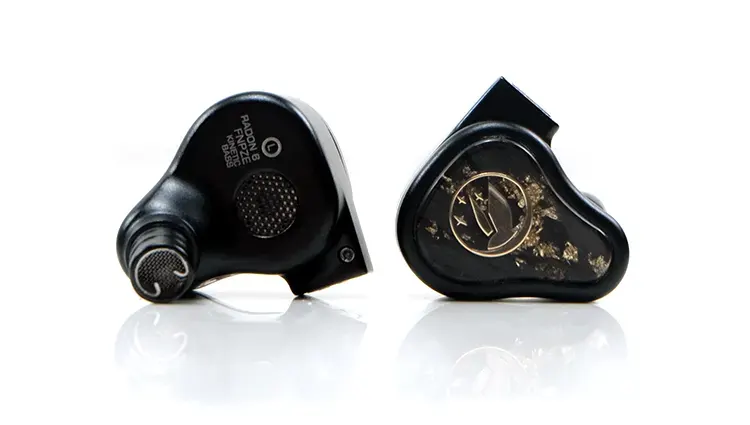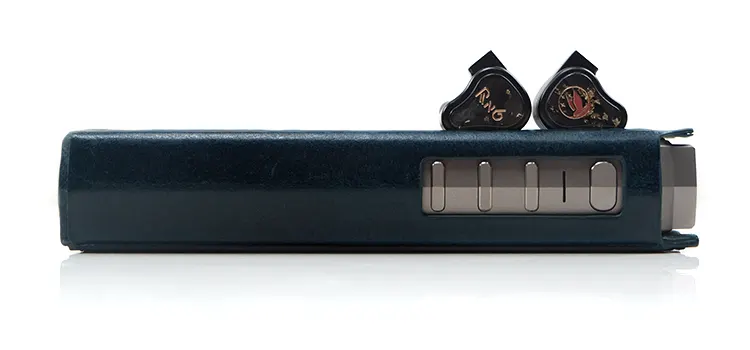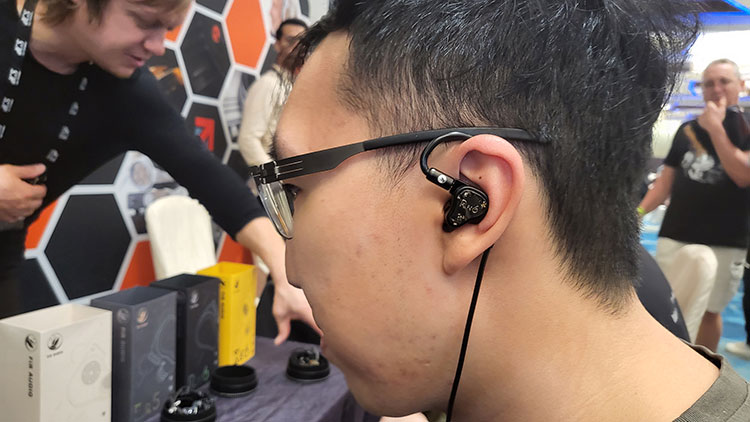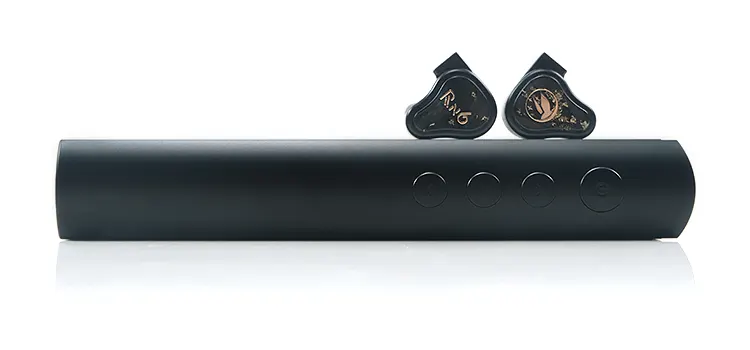Sound Impressions
The following sound impressions were created using the iBasso DX320 MAX Ti and the HiBy RS8 4.4mm balanced outputs as the main sources combined with the Symbios tips, the red ATOM XS filter, and the stock Radon 6 cable.
Summary
With the out-of-the-box ATOM XS red filter attached, the Radon 6 is an effortlessly articulate and surprisingly smooth-sounding high-end monitor.
I used ‘surprisingly’ in my opening statement because I was expecting a typically lean and shallow sound with more treble emphasis with the least isolating red ATOM XS filter but this wasn’t the case at all.
It has a lighter weight compared to the other filters but the general coloration and frequency bias is still very much to the natural and balanced side of the spectrum.
I must give credit also to the Symbios tips here for bringing a pleasing level of bass weight and punch to the presentation, more so than the foam tips that tend to comparatively dampen the thrust and dynamics of the performance.
It delivers some excellent bass weight and beautiful bass-to-mid separation with one of the purest smoothest higher register vocal performances from a high-end monitor I have heard with the custom format Multiverse Mentor being the only recent high-end IEM I have heard that can beat it.
It’s more tranquil and controlled than the aggressive monster that is the custom-format Krypton 5 with a more open and articulate midrange proving to be the difference maker.
However, with the matching silver ATOM XS modules attached, I actually found the Radon 6 sub-bass extension and quality to be on par with the Krypton 5 which kind of shocked me given how much I respect the power and punch of the Krypton 5.
The key change is the Radon 6 mid-bass bloom, which is more pulled back creating better space and clarity which is a tuning I tend to go for when I want maximum music genre flexibility.
Frequency Response
The precise FR of the Radon 6 is flexible depending on what ATOM XS filter you use. There is core FR with a slight sub-bass bias up to 60-70Hz then a sharper drop in the mid/upper bass compared to the Xenon 6 and a flatter response curve up to 1k.
With the stock red filter, you still get a nice sub-bass lift from that Kinetic Bass 10mm driver but it’s the least dB lift compared to the other extreme, the gold filter, which gives both the lows a more substantial level of presence.
Both black and silver ATOM XS filters sit somewhere in-between with the black the more balanced sounding of the two for bass weight and presence.
From 2-5k you get a lift in the Radon 6 FR, enough to flesh out a vocal presence with higher-pitching vocals, in particular, benefiting from the enhanced presence. It’s stronger in forwardness compared to the Viking Ragnar but it’s not as forward as the strong upper-mid pitch of the Empire Ear’s Odin.
One thing to note is the lack of narrow deep dips in the upper mids of the Radon 6 FR. This one remains fairly consistent and very subtly rises around 5k giving percussion passages and some midrange upper harmonics a nice crispness to them with the red filter.
There is also a subtle 8-9k peak but it’s very nuanced and with the right source you barely hear it. I could pick up on a little bit of stress on the harmonics with sharper sources such as the Class AB/SS mode for the N8ii or the Questyle M15 but the likes of the DX320 MAX Ti and the Cayin N7 sounded pure and correct to my ear.
Timbre
On a high level, the Radon 6 has a wonderfully smooth and natural-sounding timbre. It will also deliver some pleasing upper-mids and lower treble fill that’s tastefully tuned to bring out a bit of sparkle in higher-register instruments combined with an excellent Kinetic Bass dynamic driver to give it some much-needed depth and power.
The mids are wonderfully articulate and precise without sounding dry or analytical in their coloration. Those OpenDriver BA modules seem to do breathy vocals so much more justice compared to the closed-tubed type older BA drivers.
Especially so with higher-register vocal sibilance which sounds natural and real rather than packed with jarring harmonic dissonance or fatiguing sharpness. It flows and connects to me, the listener, wonderfully well with excellent space around them to give them some welcome focus.
However, the Radon 6 also has some pleasing levels of transparency and as well as the ATOM XS filter system so the above is not fixed in stone.
With the Gold filter, for example, the timbre becomes thicker and warmer with more bass weight and a more rounded note through the mids. Vocals sound fulsome and smoother but you lose a bit of staging headroom and space giving it a comparatively more congested presentation.
I suspect the balanced-sounding black filter will be most useful for owners. It introduces a bit more weight and meat to instrumental/vocal notes without detracting from the clarity and openness of the Radon 6 midrange or reducing the power of the dynamic driver by too much.
Staging & Dynamics
If you find the custom-format Krypton 5 a little dark through the mids, (silver ATOM XS), the Radon 6 is almost the complete opposite with a beautifully spacious and open midrange.
There is a really wonderful balance here between depth, power, and instrumental/vocal articulation. Nothing feels forced with a very natural staging environment that is definitely bigger than your average studio but not quite to Multiverse Mentor arena levels of huge.
Where it does have an advantage over the Mentor is that bass driver. The power is excellent, producing a very planted staging quality and an excellent bass fundamental, particularly from the black filter.
The red filter does surprisingly well though and it’s one that I like using when I want the most articulate and widest presentation but still retains a dynamic and deep bass element to my listening.
I have to give credit to FIR Audio for the final OpenDriver tweeter and EST driver phasing. It’s delightfully smooth and coherent sounding, giving tracks with ethereal airy notes a degree of solidity but without pushing too hard and sounding unnatural at the same time.
That is not to say the Radon 6 will wash away sharp treble. At times with certain clean high-energy sources, the Radon 6 did pick up on it with a bit more sharpness in the lower treble but it’s not excessive enough to make me feel uncomfortable.
The filters will also change the general shape and emphasis of the Radon 6 soundstage. The red ATOM XS filter sounds the airiest and most open of the four filters with the mids and highs progressively muted downwards until you get to the golden filter which hugely ups the power and girth of the bass and lower mids making it the key focus of the presentation.
Synergy
Efficiency
The FIR Audio Radon 6 has an impedance rating of 28Ω but like the Krypton 5, there is no official weighted SPL rating.
I did compare it subjectively with the Krypton 5 using the HiBy RS8’s balance turbo mode output as well as the Cayin N7’s balanced 4.4m,m output in low gain, and in both instances, the Krypton 5 was more sensitive to volume levels and changes. You have to remember though the Krypton 5 does not use a Sonion energizer in its driver build.
Compared to Noble Audio’s Viking Ragnar flagship hybrid driver monitor which does use Sonion energizers, the Radon 6 is more efficient by several steps using the Cayin N7’s low gain balanced output.
However, it is not always the case that no energizers mean more efficiency. The 64 Audio’s U18s is rated at a much lower 8Ω impedance but with a 106dB @1kHz SPL rating. It is less sensitive by around 10 steps on the same Cayin N7 setup. Judging by these subjective comparisons the Radon 6 is quite efficient, even for a monitor using an EST energizer.
The bottom line is this is an easy in-ear monitor to drive and the bad old days of highly inefficient Sonion energizer-based IEM builds are a thing of the past. Granted, the fact that the Radon 6 only uses 1 EST driver and not a quad-array may well be a factor in its better-than-expected efficiency performance.
ATOM XS Filters
Since we reference the red ATOM XS module for our sound impressions we will leave that one out of the rundown of what you can expect with the alternative stock filters supplied with the Radon 6.
Gold
If you are switching over from the Xenon 6 and miss a bit of that voluptuous bass-rich sound signature then the gold ATOM XS filter on the Radon 6 will bring some of that flavor back into the mix.
Of the four filters, it provides the warmest and most bass-dominant tuning to the Radon 6 though the mids and highs for me are still quite clean and never sounded overly abbreviated.
Rather the bass moves forward, gains some weight, and sounds more fulsome, and that in turn, imbues the mids timbre with more even harmonics creating a generally smoother tone.
That fuller sounds leaves a little less room for instruments and vocals to dominate so your perception will be of a reduced mids and treble staging quality with your ear firmly fixed on the lower mids and bass impact.
With the iBasso DX320 MAX Ti’s clean neutral tone the gold filter works quite well since the DAP’s strength is teasing out a very clean top-end. However, with richer-sounding sources such as the Cayin RU6, it’s not as effective in terms of balance and clarity.
Silver
The Silver pulls the gold bass volume back a bit but still leaves what I would call a smooth and fulsome coloration. The soundstage is airier though not as clean or as wide as the black and red filter
With some DAPs, you can pick up a bit more on the treble overtone. Sources such as the solid-state Class AB setting on the N8ii and the Questyle M15 work well with the silver filter if you need to pick out some lower-treble overtones from the OpenDriver BA tweeter.
I found myself gravitating towards the silver ATOM XS a lot when I wanted something rich and smooth but not overly dominant on the lows.
Black
Probably the most balanced filter of the four with a nice level of bass-to-mids separation, firmer lower-mids, and improved staging dimensions in terms of width and highs. It also has a cleaner-sounding treble performance compared to the silver and gold filters.
It’s a more flexible filter for a wide range of genres with a nice lift in the sub-bass weight and presence over the more neutral red filter. I prefer its treble weight on the notes, they sound fuller but it is not quite as airy or as extended as the stock red ATOM XS.
Dongle Pairings
(All pairings were completed using the ATOM XS silver -15 dB module combined with the stock Radon 6 cable and the Symbios hybrid tips).
We tested 3 flagship dongles with the Radon 6; the Cayin RU6, the Questyle M15, and FiiO’s KA5.
The Cayin RU6 is softer and more relaxed in its delivery paired with the Radon 6. It’s excellent for projecting a holographic staging quality combined with a smooth vocal presence and rich wet mid-bass response. Of the three dongles tested it’s also one of the most forgiving performances.
The Radon 6 sub-bass presence was much better than I expected from this pairing but not quite the same dynamic snap as the Questyle M15. The RU6/Radon 6 is an ideal pairing for vocal-centric standards and easy-listening classics with the Radon 6.
The Questyle M15 is more neutral sounding delivering a cooler tone. It will tease out a stronger treble presence from the Radon 6 mid-high OpenDriver BA.
It has the best dynamic range, the blackest background with the most powerful sub-bass performance of the 3 dongles tested with the Radon 6. I love this pairing with arena rock and synth wave that demand a clean tone and plenty of pinpoint clarity.
The FiiO KA5 toes a middle path between the two sounding more neutral compared to the RU6 but denser and warmer compared to the M15. The Radon tonal quality comes across as more analog than clinical with this source and works nicely for Motown or classic R’n’B vocal performances.
However, the KA5 pairing lacks the holographic spaciousness of the RU6 pairing, sounding more studio produced than live in its staging projection. It also does not quite offer the same impressive depth and power compared to the M15/Radon 6 pairing.
DAP Pairings
The Radon 6 responded very well indeed to our selected DAP pairings, showing a degree of flexibility and good transparency. None of the DAP pairings had any background hiss with the main differences coming from the coloration and bias on the Radon 6.
The iBasso DX320 MAX Ti produced the cleanest performance and probably the most dynamic of the sources. The Radon 6 sounded beautifully detailed and very articulate.
Of the four it also sounded the most neutral pairing with the strongest treble presence though not harsh by any means, rather just the pairing with the most sparkle.
The Cayin N8ii‘s Class AB/SS timbre mode pairing also elicited a stronger treble response from the Radon 6. However, it felt a little sharper and not as refined as the DX320 MAX Ti pairing.
For the N8ii, I much preferred Class A with SS or Class AB with the tube timbre mode. You get a nice bloom in the vocal presence and a sweeter sparkle in the highs but perhaps not quite as thick and dense on the sub-bass performance compared to the RS8 and the N7. I would pick the N8ii if you wanted the smoothest vocal representation from the Radon 6 though.
The N7 and the RS8 have the densest sub-bass response with the Turbo mode 4.4mm balanced out of the RS8 a bit snappier than the N7/Radon 6 pairing. However, the RS8 vocal on the Radon 6 is more neutral and does not leap out quite as much as the N8ii performance.
The N7 is a good all-rounder with a thick timbral coloration and excellent wide staging capability. However, you do have to give up a little bit in terms of resolution compared to the other 3.

